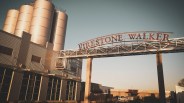Out of the 8,000-plus breweries in America today, there aren’t many that can say they survived Prohibition. Chief among that small group (and the even smaller group that could be considered “craft breweries”) is Anchor Brewing out of San Francisco, CA. This year they celebrate 125 years in operation. Think about that for a second: World War I, Prohibition, World War II, the moon landing, the first Black president — all these have come and gone and Anchor Brewing is still here.
Long defined by its traditional hand-drawn art on bulbous brown bottles, 2021 also marks a new direction with branding for Anchor — and one that produced mixed results initially. But it still feels authentic to Anchor, and rebranding an icon always comes with a sense of loss for how much we didn’t appreciate how unique and genuine what we just lost truly was.
 Anchor Brewing
Anchor BrewingSince 1896 Anchor Brewing has pioneered an endless list of innovations and American firsts in craft beer. From brewing the first modern American IPA in 1975 (even though Liberty Ale wasn’t labeled as such) to reintroducing dry-hopping to America to bringing open-fermentation stateside to keeping steam beer alive to producing the best Christmas beer-drinking tradition we have. These are just a few of the monumental achievements we can place at the feet of Anchor, a lot of which are due to owner Fritz Maytag who owned Anchor and revitalized it from 1965 to 2010.
To get some insight into the past 125 years of Anchor and the brewery’s future, we chatted with Anchor brewmaster Tom Riley and pilot brewer Dane Volek.














